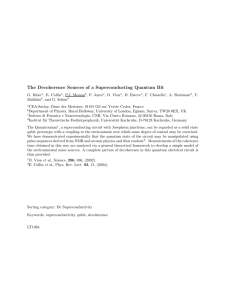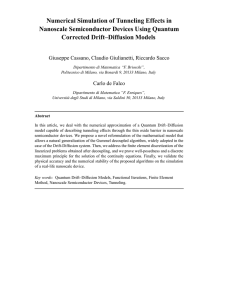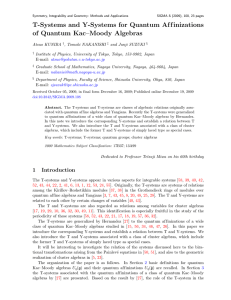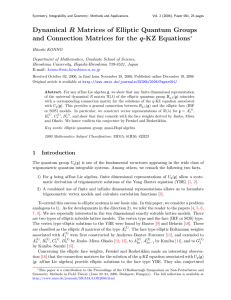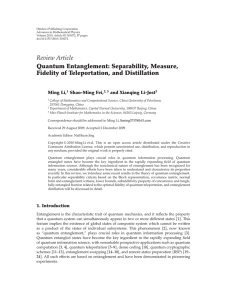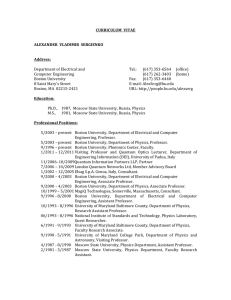QUANTUM DIMENSION
advertisement
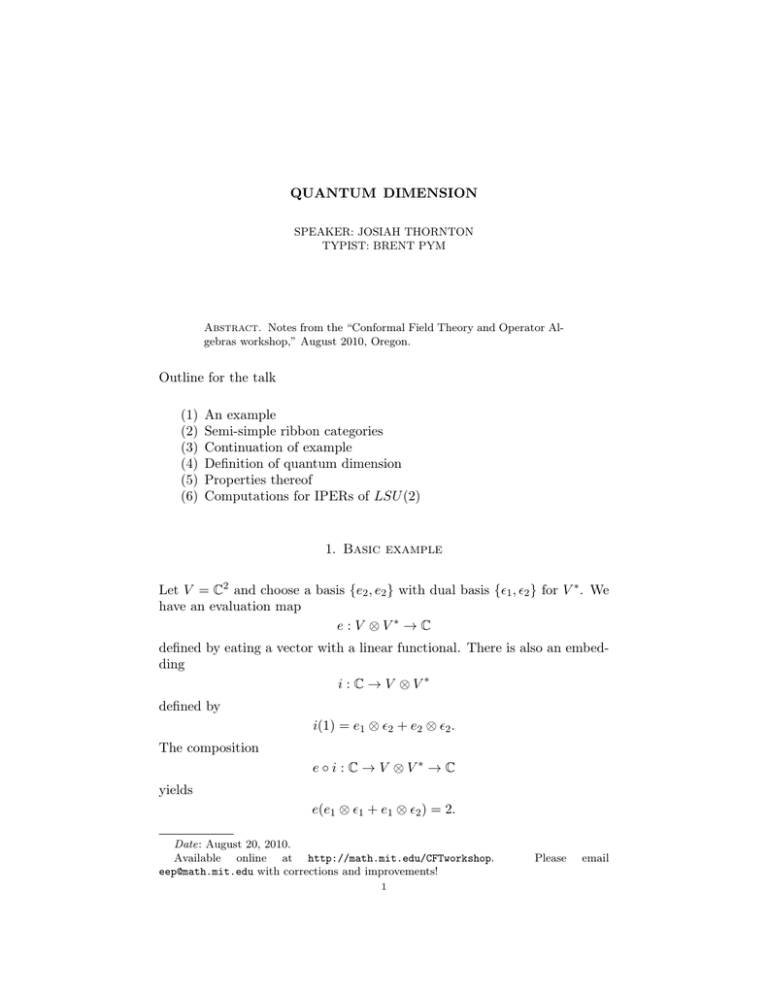
QUANTUM DIMENSION
SPEAKER: JOSIAH THORNTON
TYPIST: BRENT PYM
Abstract. Notes from the “Conformal Field Theory and Operator Algebras workshop,” August 2010, Oregon.
Outline for the talk
(1)
(2)
(3)
(4)
(5)
(6)
An example
Semi-simple ribbon categories
Continuation of example
Definition of quantum dimension
Properties thereof
Computations for IPERs of LSU (2)
1. Basic example
Let V = C2 and choose a basis {e2 , e2 } with dual basis {1 , 2 } for V ∗ . We
have an evaluation map
e:V ⊗V∗ →C
defined by eating a vector with a linear functional. There is also an embedding
i:C→V ⊗V∗
defined by
i(1) = e1 ⊗ 2 + e2 ⊗ 2 .
The composition
e◦i:C→V ⊗V∗ →C
yields
e(e1 ⊗ 1 + e1 ⊗ 2 ) = 2.
Date: August 20, 2010.
Available online at http://math.mit.edu/CFTworkshop.
eep@math.mit.edu with corrections and improvements!
1
Please
email
2
SPEAKER: JOSIAH THORNTON TYPIST: BRENT PYM
2. Semi-simple ribbon categories
Let C be a C-linear abelian category equipped with the following structure:
• ⊗ : C × C → C, a bilinear functor
∼
• αU,V,W : (U ⊗ V ) ⊗ W −→ U ⊗ (V ⊗ W ), a functorial isomorphism
for all U, V, W ∈ C
• I ∈ C such that End(I) = C, together with functorial isomorphisms
∼
λV : I ⊗ V −→ V
and
ρV : V ⊗ I → V
for all V ∈ C
Such a structure is called a monoidal structure.
Example. V ec(C), together with the tensor product ⊗.
Example. Rep(SU (N )) with tensor product H1 ⊗ H2 of the underlying
Hilbert spaces H1 , H2 ∈ Rep(SU (N )) and the action
g(x ⊗ y) = g(x) ⊗ g(y)
for g ∈ SU (N ) and x ∈ H1 , y ∈ H2 .
.
Definition. A braiding is given by isomorphisms
∼
σV W : V ⊗ W −→ W ⊗ V,
which are functorial in V, W ∈ C, and satisfy some commutative diagrams.
A category with a monoidal structure and a braiding is called a braided
monoidal category.
Example. For the categories V ec(C) and Rep(SU (N )), the isomorphisms
τV W : V × W → W × V
given by
τ (v, w) = (w, v)
give a braiding.
Rigidity is given by homomorphisms
eV : V ∗ ⊗ V → I
and
iV : I → V ⊗ V ∗ ,
where V is the right dual of V . These maps must make the following diagrams commute:
QUANTUM DIMENSION
3
Example. For V ec(C), we have V ∗ = Hom(V, C) and the maps eV and iV
as before.
Example. For Rep(G), the representation on the dual of H is given by
continuous linear functionals H∗ = C(H, C) with the representation
(gf )(v) = f (g −1 v)
for f ∈ H∗ , g ∈ G and v ∈ H.
Suppose that we have a map f : U → V . We can construct a dual map f ∗
by the composition
1⊗i
1⊗f ⊗1
e ⊗1
V
V ∗ −→U V ∗ ⊗ U ⊗ U ∗ −→ V ∗ ⊗ V ⊗ U ∗ −→
U∗
Definition. A ribbon category is a rigid braided tensor category with a
∼
functorial isomorphism δV : V −→ V ∗∗ such that
δV ⊗W = δV ⊗ δW
δ I = 1I
δV ∗ = (δV∗ )−1
4
SPEAKER: JOSIAH THORNTON TYPIST: BRENT PYM
3. Quantum dimension
Let C be a semi-simple ribbon category.
Definition. Let V ∈ C and f ∈ End(V ). Define the trace of f to be the
composition
f ⊗1
e
∗
V
I
I → V ⊗ V ∗ −→ V ⊗ V ∗ → V ∗∗ ⊗ V ∗ −→
One important property of the trace is
tr(f ⊗ g) = tr(f )tr(g),
a fact which needs the ribbon structure.
Definition. The quantum dimension of V ∈ C is defined to by tr(1V ).
If there are finitely many simple objects, the quantum dimension is a real
number. For LSU (N ), the quantum dimension is, in fact, positive.
4. Calculations
Let
Nfhg = dim (Hom(Vh , Vf ⊗ Vg ))
Theorem 4.1 (Wassermann). The Connes fusion satisfies
M
Hf Hg =
Nfhg sgn(σh )Hh0
where
h0 = σ(h + δ) − δ
is a permutation.
Corollary 4.2. For G = SU (2), we have
Hl Hl = H0
Theorem 4.3. For the permutation signature f , we have
M
H Hf =
Hg
g=f +
Corollary 4.4. For G = SU (2) and 1 ≤ λ ≤ l − 1,
H Hλ = Hλ−1 ⊕ Hλ+1
QUANTUM DIMENSION
5
5. IPERs of LSU (2)
Fix a level l ∈ Z, consider
H0 , . . . , Hl ,
and define
di = dim Hi
and
dl = 1.
Proposition 5.1. For 0 ≤ i ≤ l, we have
di = dl−i ,
so that
d1 di = di−1 + di+1
and
d1 dl−i = dl−i−1 + dl−i+1 ,
and hence
di−1 = dl−i+1
for 1 ≤ i ≤ l − 1.
We can use this proposition to calculate the quantum dimensions, as in the
following picture:
6
SPEAKER: JOSIAH THORNTON TYPIST: BRENT PYM
